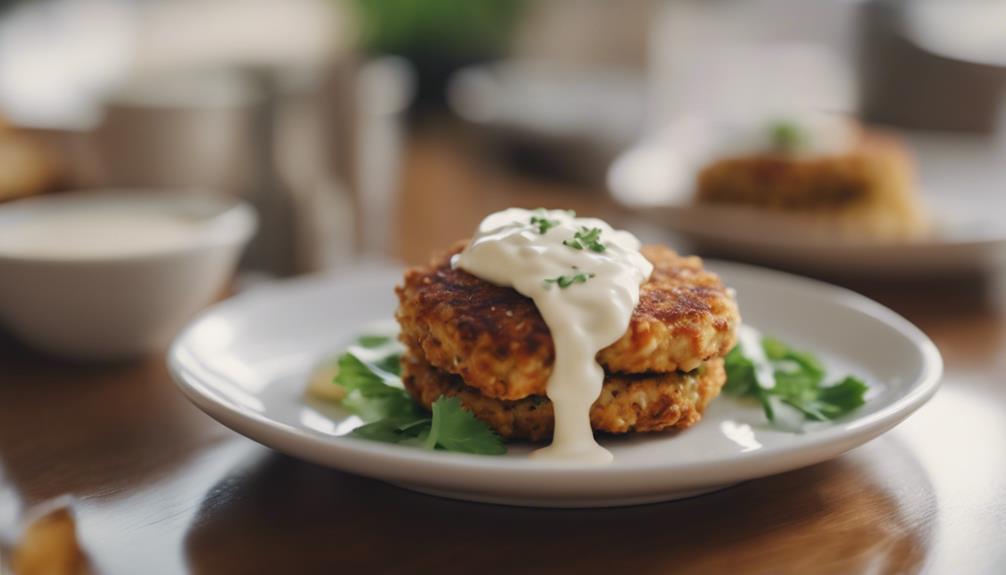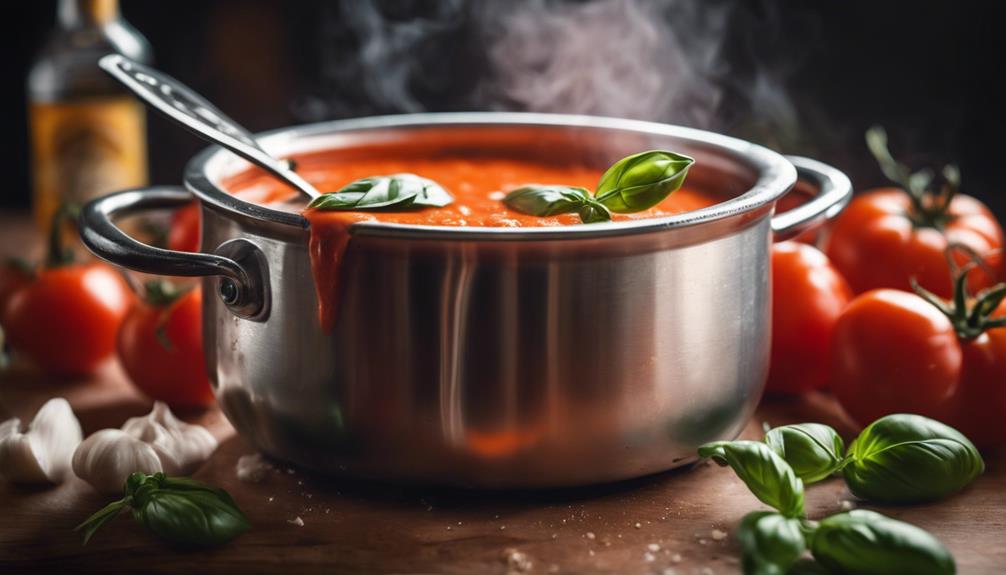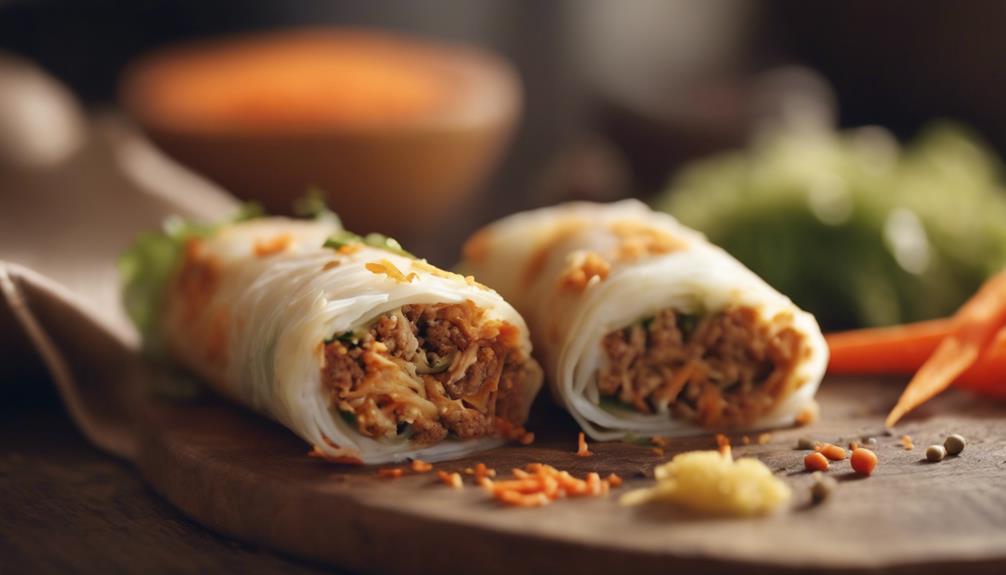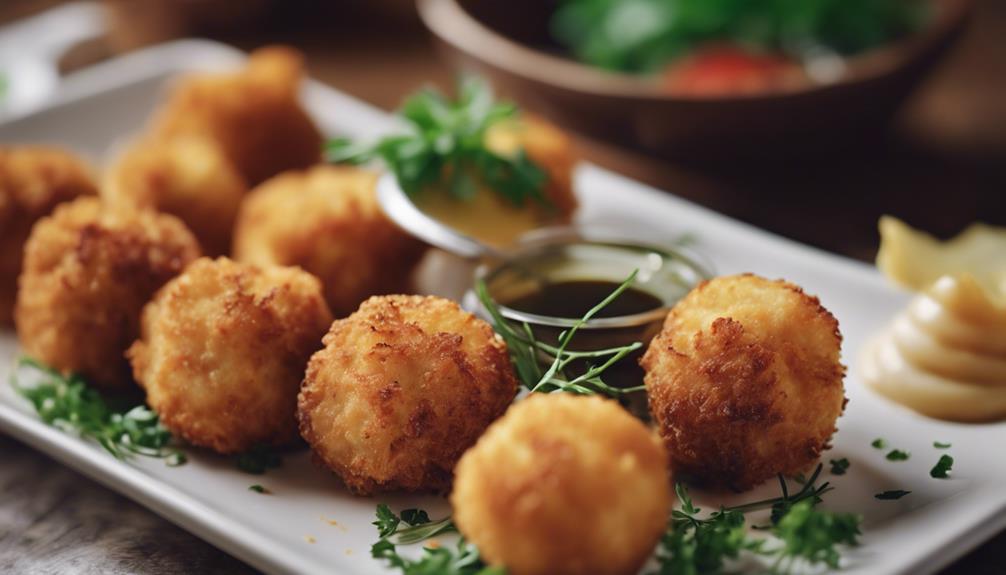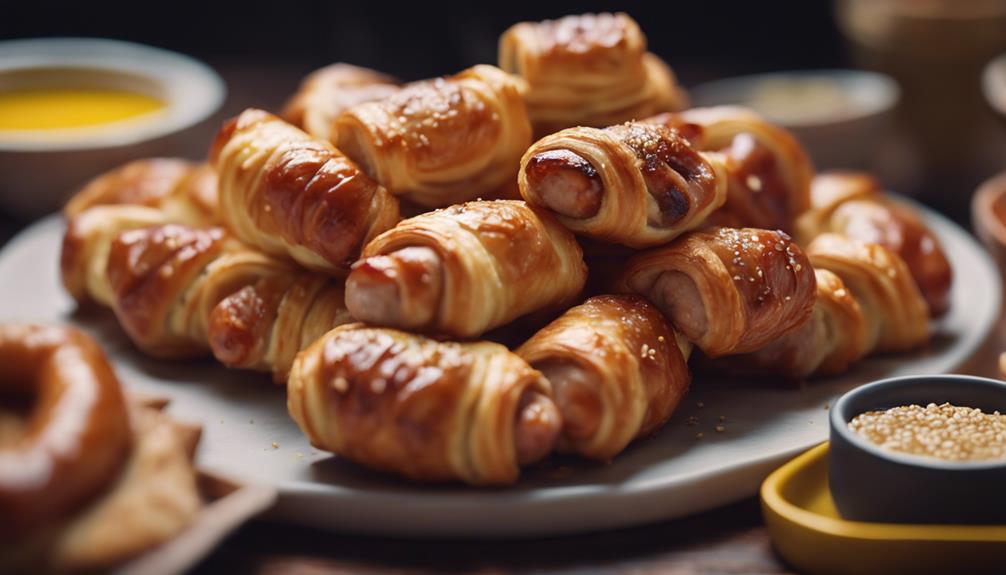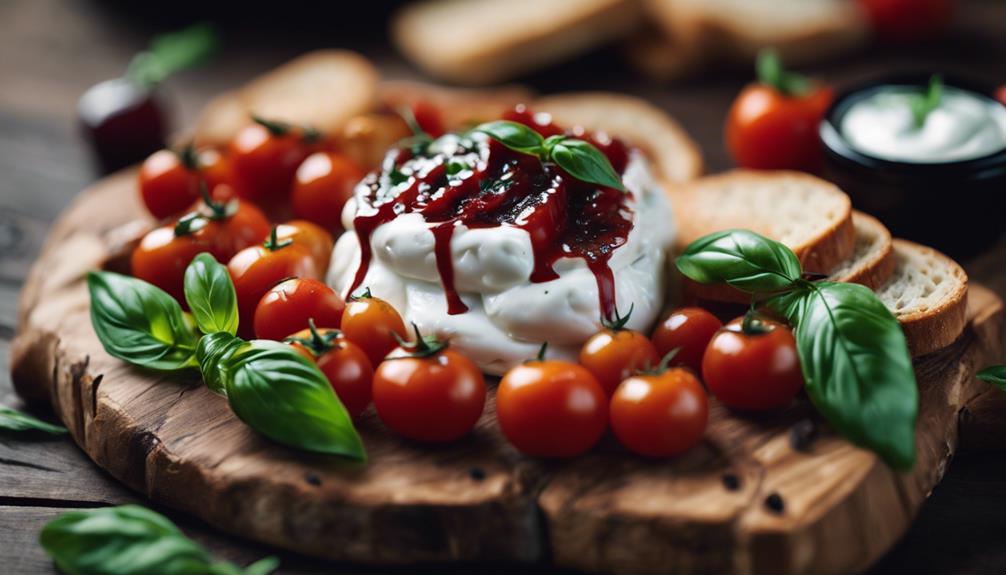When preparing crab cakes, begin by mixing lump crab meat with parsley, Worcestershire sauce, Dijon mustard, and Old Bay seasoning. Chill the mixture before cooking. Choose between jumbo lump, lump, backfin, or claw crab meat for different textures. Use Maryland Blue Crabs or Dungeness Crabs for superior quality. Enhance the flavors with bread crumbs, crackers, or potato chips, as well as ingredients like Worcestershire sauce, lemon, mayonnaise, eggs, mustard, and parsley. Pair with aioli or tartar sauce, along with beverages such as Chardonnay, Sauvignon Blanc, or a Pale Ale. When reheating, avoid using microwaves and store any leftovers properly. Perfect the skill of crafting the ultimate crab cake!
Key Takeaways
- Use high-quality lump crab meat for the best texture and flavor.
- Incorporate classic ingredients like Old Bay seasoning and Worcestershire sauce for authentic taste.
- Opt for jumbo lump or backfin crab meat for a premium experience.
- Serve with remoulade sauce and fresh herbs for a delightful combination.
- Pair crab cakes with Chardonnay or a Pale Ale for a well-rounded culinary experience.
Classic Crab Cake Ingredients
What essential ingredients make up a classic crab cake?
A classic crab cake is crafted from premium lump crab meat, a prized component that imparts a rich and delicate flavor to the dish.
Complementing the crab, the recipe typically calls for fresh parsley, adding a touch of vibrant green and a burst of herbaceous freshness.
To enhance the umami taste, Worcestershire sauce is often incorporated, infusing the crab cakes with depth and complexity.
The subtle heat of Dijon mustard not only provides a hint of spice but also acts as a binder, helping to hold the cakes together during the cooking process.
Additionally, the unmistakable blend of seasonings, such as Old Bay, contributes a signature taste that elevates the overall profile of the dish.
These meticulously selected ingredients, in combination with the binding elements like eggs and mayonnaise, work harmoniously to create the quintessential crab cake experience.
Preparation Instructions
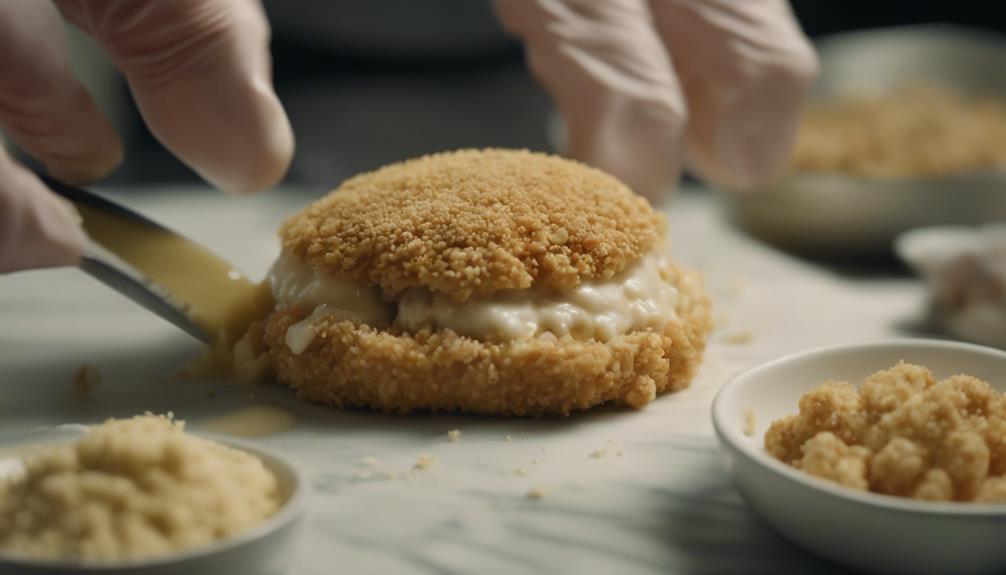
When preparing crab cakes, it's crucial to follow the recipe ingredients list meticulously to make sure the flavors blend perfectly.
The cooking instructions will guide you through each step, from mixing the ingredients to shaping and cooking the crab cakes.
Additionally, serving suggestions and sides will complement the crab cakes, enhancing the overall dining experience.
Recipe Ingredients List
To prepare the crab cakes, begin by gathering fresh lump crab meat, eggs, mayonnaise, Dijon mustard, Old Bay seasoning, and breadcrumbs for binding. These ingredients form the base of a classic crab cakes recipe.
The lump crab meat provides a sweet and delicate flavor, while the mayonnaise and Dijon mustard add creaminess and a hint of tanginess. Old Bay seasoning brings a signature blend of herbs and spices, enhancing the overall taste profile. The breadcrumbs serve as an essential element for binding the mixture together, ensuring the cakes hold their shape during cooking.
Additionally, a flavorful tartar sauce is commonly served alongside crab cakes. This sauce typically consists of ingredients like mayonnaise, Dijon mustard, relish, onion, lemon juice, salt, and pepper.
The combination of these components creates a zesty and creamy accompaniment that complements the savory crab cakes perfectly. By using these essential ingredients in the right proportions, you can create a delectable appetizer that's sure to please your guests.
Cooking Instructions Step-By-Step
Pulse LAYS Classic Potato Chips in a food processor to start preparing the crab cakes. Combine the crab meat with egg, mayonnaise, Dijon mustard, Worcestershire sauce, parsley, salt, and the crushed potato chips. Shape this flavorful mixture into patties, then allow them to chill in the refrigerator.
This step is essential as it helps the crab cakes hold their shape when cooking. When ready, heat butter in a skillet over medium heat. Cook the crab cakes until they turn a beautiful golden brown and develop a delightful crispiness on the outside.
Once cooked to perfection, serve these delectable crab cakes with a homemade rémoulade sauce made from mayonnaise, capers, lemon juice, parsley, Dijon mustard, Worcestershire sauce, salt, and pepper. The combination of the savory crab cakes and the tangy rémoulade sauce creates a harmonious blend of flavors that's sure to impress your taste buds.
Serving Suggestions and Sides
For an enticing and well-rounded dining experience, consider exploring various serving suggestions and side dishes that complement the savory crab cakes.
- Enhance the presentation of crab cakes by serving them on a bed of mixed greens or with a side of coleslaw.
- Create a delightful contrast in flavors by pairing crab cakes with a tangy and zesty tartar sauce or a creamy lemon aioli.
- For a complete meal, consider serving crab cakes alongside roasted vegetables, quinoa salad, or garlic mashed potatoes.
- Elevate the dish by garnishing with fresh herbs like parsley, chives, or dill for a pop of color and added fragrance.
To cater to a larger crowd or as a main course, consider doubling the recipe and serving the crab cakes as sliders on toasted buns with lettuce and tomato.
These suggestions won't only enhance the flavor profile of the dish but also add visual appeal to your dining experience, making it a memorable treat for your guests.
Cooking Techniques for Crab Cakes
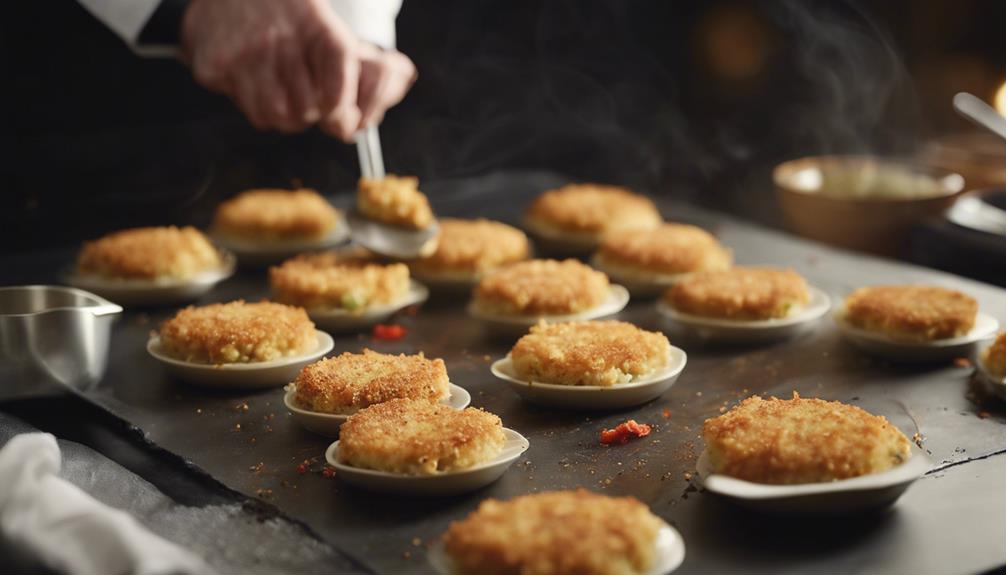
Mix the ingredients for your crab cakes carefully to avoid shredding the delicate crab meat and preserve its texture and flavor.
When making the best crab cakes, it's essential to use fresh lump crab meat for the best taste and quality.
After refrigerating the crab cake mixture for at least 1 hour to allow the flavors to meld, shape the cakes gently to maintain their structure.
When cooking the crab cakes, begin by pan-searing them in a preheated pan with butter or oil to achieve a crispy exterior. For even cooking, consider finishing the crab cakes in the oven after pan-searing. This method ensures that the crab cakes are thoroughly heated and cooked through.
Experimenting with different seasonings and fillers can add a unique twist to traditional crab cakes while still honoring their classic appeal.
Choosing the Best Crab Meat
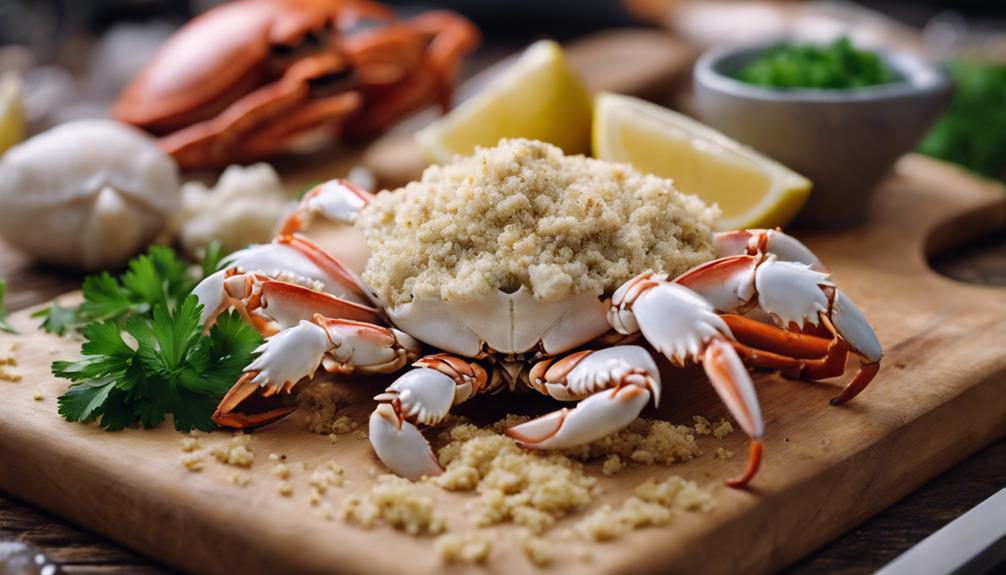
When selecting the best crab meat for your crab cakes, consider the different grades available, including jumbo lump, lump, backfin, and claw.
Freshly picked crab meat from Maryland Blue Crabs or Dungeness Crabs is often preferred for its superior quality.
Moreover, it's important to assess whether the crab meat is sourced sustainably and to decide between fresh and canned options based on your preferences and recipe requirements.
Crab Meat Grades
When selecting the best crab meat for your crab cakes, consider the different grades available to find the texture and flavor profile that best suits your dish. Here are some key points to keep in mind:
- Jumbo Lump crab meat: This type comes from the swimmer fins of the crab and offers large, whole pieces that are highly prized for their appearance and taste.
- Lump crab meat: Consisting of smaller, broken pieces from the body of the crab, this grade provides a slightly different texture compared to Jumbo Lump.
- Backfin crab meat: Known for its flakier texture and sourced from the body of the crab, Backfin is a popular choice for crab cakes due to its consistency.
- Claw crab meat: With a darker color, less sweetness, and a stronger flavor, Claw meat is often used in soups or stews for its robust taste.
For the best flavor and texture in your crab cake mixture, freshly hand-picked or fresh-picked crab meat is recommended.
Fresh Vs. Canned
For the best flavor and texture in your crab cakes, choose fresh crab meat over canned varieties to guarantee a more authentic and delicious dining experience. Fresh crab meat, such as jumbo lump or lump crab meat, is preferred due to its sweet and delicate flavor profile. On the other hand, canned crab meat, often pasteurized and containing additives, can alter the taste and texture of your crab cakes. Opting for refrigerated or fresh-off-the-boat crab meat ensures a more authentic culinary experience.
| Criteria | Fresh Crab Meat | Canned Crab Meat |
|---|---|---|
| Flavor | Sweet and delicate | May have a different taste |
| Texture | Firm and succulent | Can lack freshness |
| Processing | Typically minimal processing | Often pasteurized with additives |
Sustainable Sourcing
To guarantee you're selecting the best crab meat, prioritize sourcing from sustainable suppliers certified by organizations like MSC for responsible fishing practices. When choosing crab meat, consider the following:
- Certifications: Look for labels like MSC to confirm the crab meat is sustainably sourced.
- Protecting Marine Ecosystems: Sustainable crab meat helps safeguard marine ecosystems and ensures the longevity of crab populations.
- Local Sourcing: Consider purchasing locally sourced crab meat to reduce the carbon footprint associated with transportation.
- Overall Impact: Sustainable sourcing of crab meat contributes to the overall health of our oceans and seafood industry.
Variations of Crab Cake Fillings
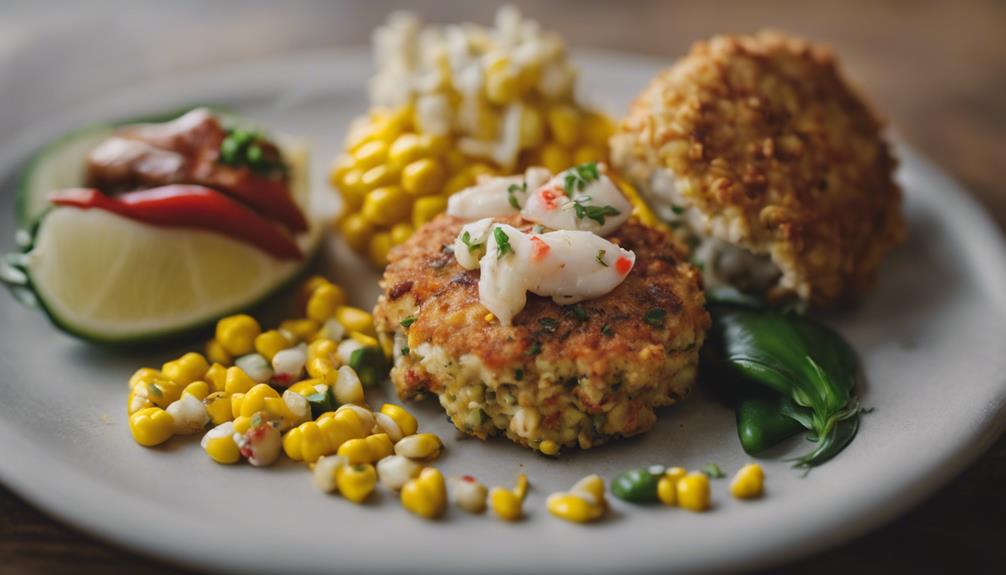
Enhancing the flavors and textures of crab cakes can be achieved through a variety of fillings such as bread crumbs, crackers, or potato chips. When preparing crab cakes, the choice of filler plays an important role in determining the overall taste and consistency of the dish.
Some popular ingredients used in crab cake fillings include Worcestershire sauce for a savory kick, lemon for a hint of freshness, and fresh crab meat sold in markets to guarantee quality. The best crab cake recipe often includes a combination of bread crumbs, mayonnaise, eggs, Dijon mustard, and parsley to enhance the flavors and bind the ingredients together.
Serving Suggestions for Crab Cakes
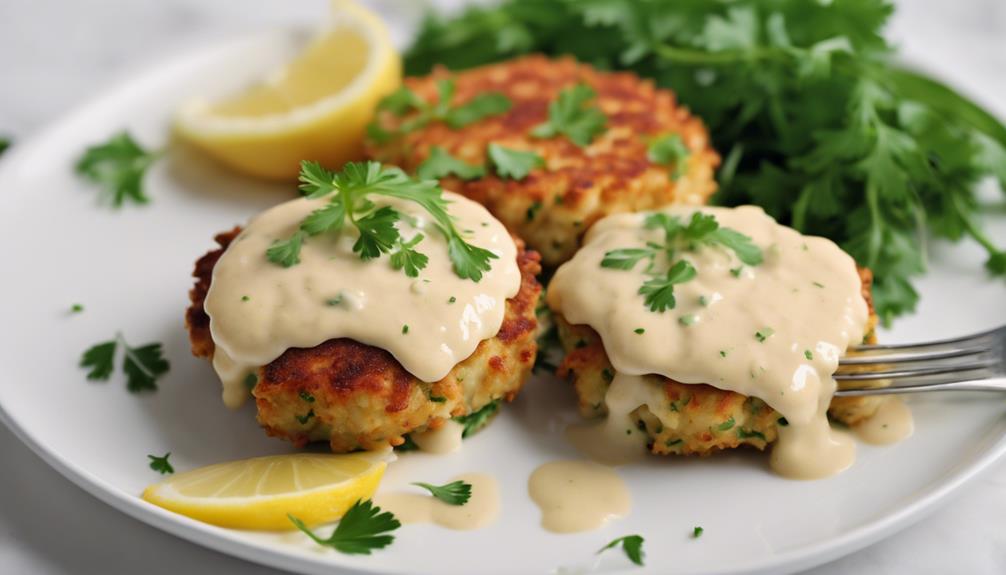
When serving crab cakes, you can explore various plating options to elevate the dining experience.
Dipping sauces like aioli or tartar sauce can complement the flavors of the crab cakes.
Garnish ideas such as a sprinkle of fresh herbs or a drizzle of balsamic reduction can add a touch of sophistication to your dish.
Plating Options
Consider presenting your crab cakes on a bed of mixed greens for a light and invigorating touch.
To elevate your plating options, here are some suggestions:
- Serve crab cakes as a main dish with a side of coleslaw or a lemon wedge for added flavor.
- Create mini crab cake sliders by sandwiching them between slider buns with a dollop of tartar sauce.
- For a more elegant presentation, plate the crab cakes on individual appetizer plates drizzled with a creamy remoulade sauce.
- Garnish crab cakes with fresh herbs like parsley or microgreens for a pop of color and added freshness.
These ideas can enhance the visual appeal of your crab cakes while also providing complementary flavors and textures.
Whether you opt for a casual gathering or a formal dinner party, the plating options can make your dish stand out and impress your guests.
Dipping Sauces
To enhance your dining experience with crab cakes, explore various dipping sauces that can elevate the flavors and textures of the dish. Popular choices include tartar sauce, lemon aioli, and cocktail sauce.
Tartar sauce, a classic accompaniment, is crafted from mayonnaise, pickles, and spices. Lemon aioli offers a zesty kick with a creamy garlic-infused mayonnaise base, while cocktail sauce brings a tangy and spicy flavor profile, usually comprising ketchup, horseradish, and Worcestershire sauce.
These flavorful dipping sauces serve to enhance the taste of crab cakes by providing a delightful contrast to the savory seafood flavors. Whether you prefer the traditional tanginess of tartar sauce, the citrusy notes of lemon aioli, or the spicy kick of cocktail sauce, each option complements the crab cakes in a unique way, adding depth and richness to every savory bite.
Experimenting with these dipping sauces can truly elevate your crab cake experience and delight your taste buds with a burst of complementary flavors.
Garnish Ideas
Enhance the presentation and flavor profile of your crab cakes by exploring creative garnish ideas that add visual appeal and complementary tastes to your dish. When serving your crab cakes, consider these garnish ideas to elevate your appetizer:
- Garnish with a squeeze of fresh lemon: A touch of citrus adds brightness to the savory crab cakes and enhances their overall flavor.
- Sprinkle chopped parsley or microgreens: These vibrant greens not only add a pop of color to your dish but also provide a fresh and herbaceous taste.
- Serve on a bed of mixed greens or arugula: Placing your crab cakes on a bed of greens not only enhances the visual presentation but also offers a light and balanced accompaniment.
- Drizzle with homemade remoulade sauce: The tangy and creamy finish of a remoulade sauce complements the flavors of the crab cakes perfectly, adding a delightful richness to each bite.
Consider pairing your crab cakes with a side of coleslaw or a invigorating cucumber salad for a well-rounded meal that will delight your taste buds.
Perfecting the Remoulade Sauce
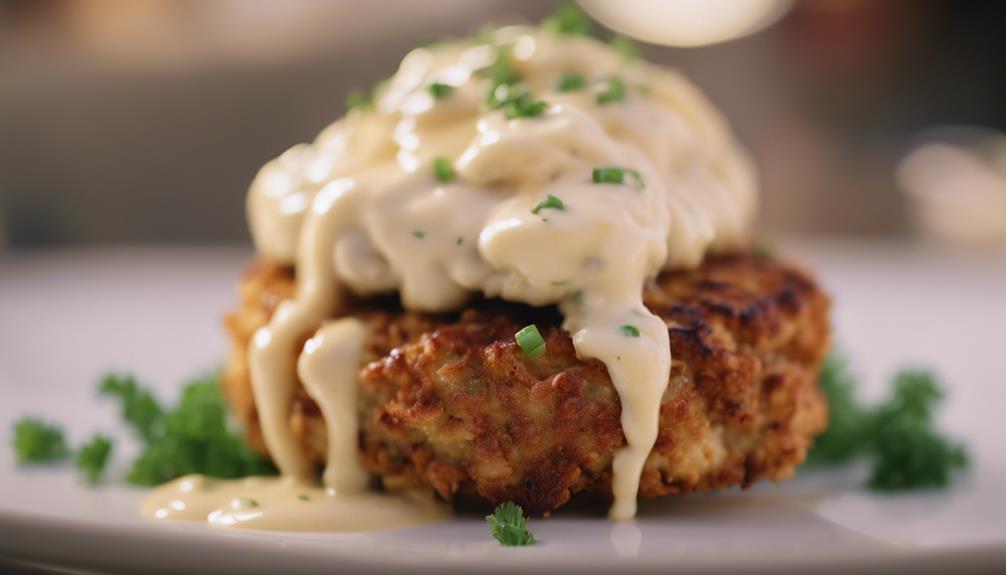
Crafting a delectable remoulade sauce is crucial to elevating the flavors of your crab cakes. This classic accompaniment is a harmonious blend of mayonnaise, capers, Dijon mustard, Worcestershire sauce, and fresh parsley. The mayonnaise provides a creamy base, while the capers add a briny kick that complements the sweetness of the crab.
Dijon mustard and Worcestershire sauce contribute depth and tanginess, enhancing the overall taste profile. Fresh parsley not only adds a vibrant touch of color but also brings a herbaceous freshness to the sauce.
To achieve the best results, you can make the remoulade sauce ahead of time. Allowing it to chill will give the flavors time to meld together, intensifying the taste experience when paired with the crab cakes. By preparing the sauce in advance, you make certain that it's ready to serve at the perfect moment, enhancing the overall dining experience for you and your guests.
Presentation Tips for Crab Cakes
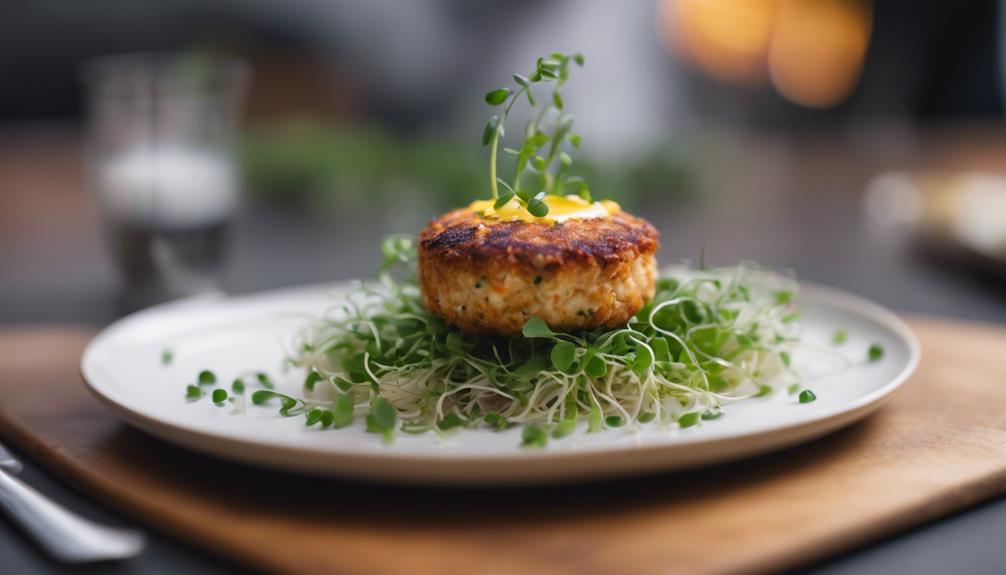
For an appealing presentation that complements your perfectly crafted crab cakes, consider these effective tips:
- Garnish crab cakes with a sprinkle of fresh parsley or microgreens for a pop of color and added freshness.
- Serve crab cakes on a bed of mixed greens or arugula to create an attractive presentation.
- Drizzle a zesty sauce like lemon aioli or rémoulade in an artistic pattern on the plate before placing the crab cakes.
- Consider using a ring mold to shape the crab cakes for a more uniform and professional presentation.
To elevate the visual appeal of your crab cakes, a touch of garnish such as fresh parsley or delicate microgreens won't only add a burst of color but also enhance the overall freshness of the dish. Placing the crab cakes on a bed of mixed greens or peppery arugula can provide a visually pleasing contrast and elevate the presentation. Drizzling a tangy sauce like lemon aioli or rémoulade in an artistic pattern on the plate before positioning the crab cakes can add a touch of sophistication. Using a ring mold to shape the crab cakes will guarantee a neat and professional look, enhancing the overall aesthetic appeal.
Pairing Beverages With Crab Cakes
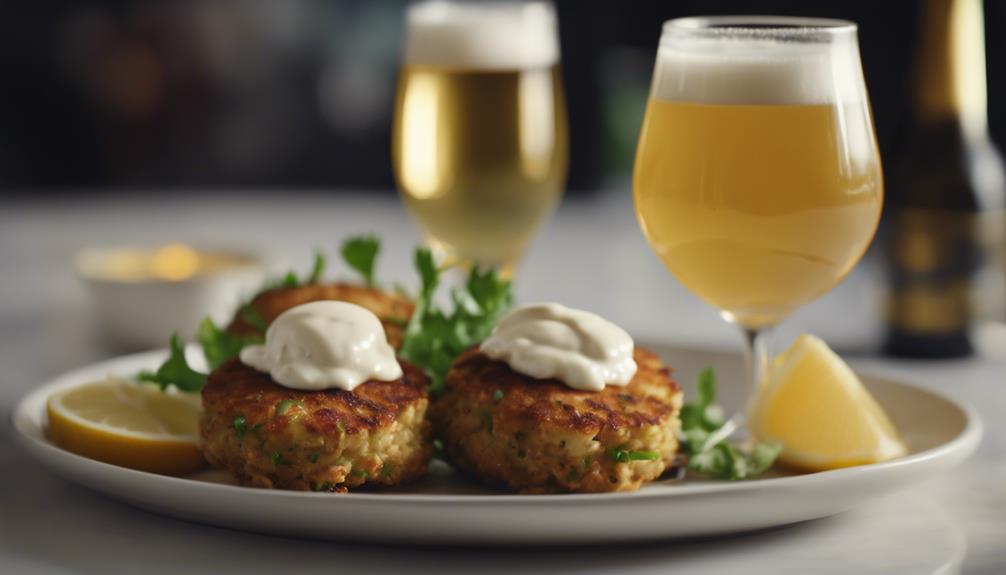
Consider pairing your crab cakes with a crisp and invigorating white wine like a Chardonnay or Sauvignon Blanc. The acidity of these wines complements the richness of the crab cakes, creating a delightful balance of flavors.
If you prefer beer, opt for a light and citrusy Belgian Witbier or a Pale Ale to enhance the taste experience.
For a non-alcoholic option, try a sparkling water infused with lemon or cucumber to provide a rejuvenating contrast to the savory crab cakes.
Looking for a more celebratory pairing? A dry and effervescent Champagne or Prosecco can elevate the seafood flavors in your crab cakes.
Don't be afraid to explore other beverage options like a dry hard cider or a fruity Rosé to discover the perfect complement for your dish. Experimenting with different pairings can add an exciting element to your dining experience and enhance the enjoyment of your crab cakes.
Storage and Reheating Tips
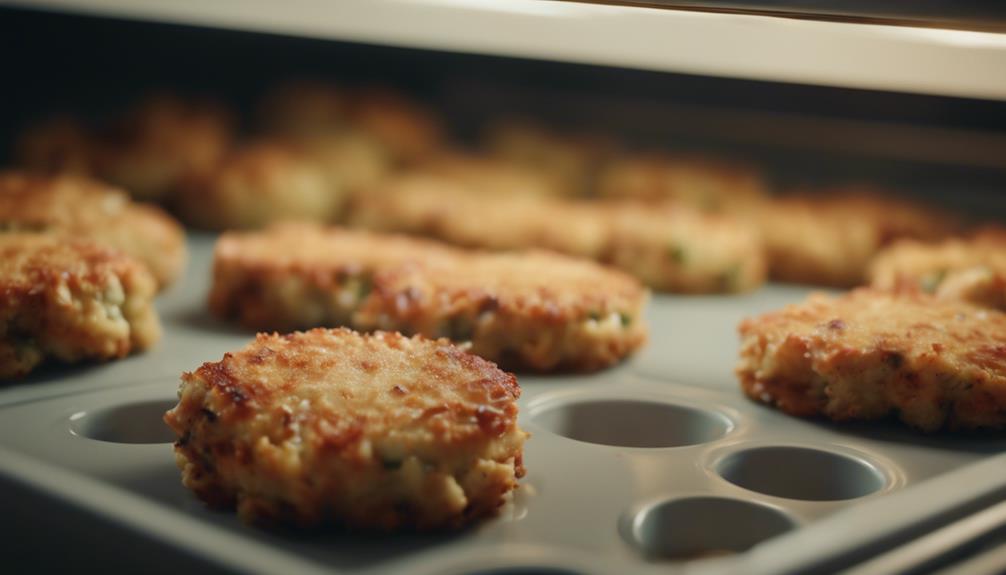
To maintain the quality of your crab cakes for future enjoyment, guarantee proper storage and reheating techniques are employed.
When dealing with leftover crab cakes, it's important to follow these tips:
- Store: Keep any leftover crab cakes in an airtight container in the refrigerator, ensuring they stay fresh for up to 3 days.
- Reheat: When reheating, avoid using the microwave as it can make the crab cakes soggy. Instead, opt for baking in a preheated oven at 350°F for 10-15 minutes for best results.
- Crispy Texture: For a crispy texture reminiscent of freshly made crab cakes, consider reheating them in a skillet with a bit of butter or oil over medium heat.
- Proper Storage: Proper storage and reheating methods are key to maintaining the flavor and texture of your crab cakes, ensuring a delicious leftover meal every time.
Frequently Asked Questions
What Are Crab Cakes Usually Served With?
When you serve crab cakes, they're usually accompanied by tartar sauce or rémoulade on the side for extra flavor. A squeeze of fresh lemon highlights the seafood taste. Pairing them with a side salad or coleslaw is popular.
What Is the History of Crab Cakes?
When exploring the history of crab cakes, envision the shores of Maryland where blue crabs reign supreme. Dating back to the 1930s, these savory delights have become a timeless classic loved nationwide.
How Are You Supposed to Eat Crab Cakes?
When enjoying crab cakes, you're supposed to savor the crispy exterior and moist interior. Enhance the flavors with a squeeze of fresh lemon. Pair with side salad, coleslaw, or tartar sauce. Best eaten hot!
Are Crab Cakes a Maryland Thing?
Yes, crab cakes are definitely a Maryland thing. They are a classic dish deeply rooted in the state's culinary history, showcasing the abundance of fresh blue crab. You'll love the sweet and savory flavors!
What Makes Camembert Stuffed Mushrooms a Gourmet Appetizer Compared to Crab Cakes?
The camembert stuffed mushrooms recipe offers a gourmet twist to traditional appetizers like crab cakes. The rich and creamy cheese paired with earthy mushrooms create a luxurious flavor profile that elevates it to a more sophisticated level. It’s a perfect choice for those looking for a decadent and impressive appetizer. Ideal for dinner parties or intimate gatherings, the camembert stuffed mushrooms recipe is both easy to prepare and guaranteed to impress your guests. Serve them alongside a crisp white wine to enhance the dish’s creamy and earthy notes, creating a truly indulgent culinary experience. With its blend of elegance and simplicity, the camembert stuffed mushrooms recipe is sure to become a go-to favorite for any special occasion. This camembert stuffed mushroom recipe also offers versatility in presentation, allowing you to showcase your creativity by garnishing with fresh herbs or serving on a beautiful platter. Whether as a starter for a multi-course meal or a delightful standalone snack, the camembert stuffed mushroom recipe adapts effortlessly to any occasion. Its combination of gourmet flavors and straightforward preparation ensures it will remain a beloved choice among food enthusiasts.
Conclusion
To sum up, crab cakes are a timeless appetizer that never fails to impress. With the right ingredients, preparation techniques, and attention to detail, you can create a savory dish that will delight your guests.
Remember to pair your crab cakes with a delicious remoulade sauce and a rejuvenating beverage for the perfect culinary experience.
Whether enjoyed as a starter or main course, crab cakes are sure to satisfy your cravings for seafood delights.
